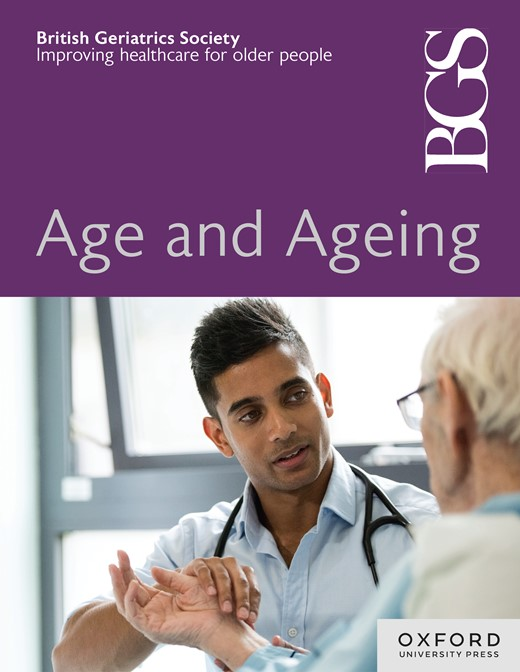3068 Promoting the reduction of sedative use in older adults with delirium—a QI project
IF 6
2区 医学
Q1 GERIATRICS & GERONTOLOGY
引用次数: 0
Abstract
Introduction Non-pharmacological de-escalation techniques are effective in managing agitated patients with delirium yet are often overlooked in favour of pharmacological management. Sedatives are prescribed despite increased falls and extrapyramidal side effects. We used quality improvement methodology with the aim of reducing sedative use in older adults with delirium in an acute UK hospital. Methods Utilising inpatient electronic prescribing records, we collected data on all patients aged ≥65 prescribed a sedative acutely during May 2022 in a 575-bedded acute district general hospital. Based on best-practice guidelines, formulated standards were: <10 cases of sedatives prescribed monthly, and in individuals with sedatives prescribed 100% screened for delirium, 90% have non-pharmacological delirium management methods trialled first, 100% have rationale for sedative prescription documented, and 100% of sedative prescriptions reviewed within 24 hours. Of cases prescribed a benzodiazepine, 100% should have contraindication to haloperidol documented. We conducted one Plan-Do-Study-Act (PDSA) cycle, focussing on hospital-wide education and the implementation of aide-memoires, and repeated our audit in May 2024. Results Total sedatives prescribed declined significantly at re-audit (42 vs 72), with 28 individuals meeting inclusion criteria (vs 36 at baseline). Rates of delirium screening remained static (93%) while documentation of non-pharmacological methods improved by 16%. Where sedatives were used, 21% of prescriptions lacked documentation of rationale (vs 14% at baseline), no instances of contraindication to haloperidol were recorded (vs 6%), and only 68% of prescriptions were reviewed within 24 hours (vs 75%). Sedation for a scan reduced by the largest margin (18% of prescriptions vs 34%). Conclusions The total number of sedatives prescribed decreased through education initiatives. Where prescribed, fewer standards were met, including fewer documentations of rationale and medication reviews. Future work will be to implement an electronic prescribing sedative care plan to encourage non-pharmacological de-escalation techniques prior to consideration of appropriate, time-limited sedative prescriptions.3068促进老年谵妄患者减少镇静剂的使用——一个QI项目
非药物降级技术是有效的管理躁动患者谵妄,但往往被忽视,有利于药物管理。尽管会增加跌倒和锥体外系副作用,医生还是开了镇静剂。我们采用质量改进方法,目的是在英国一家急性医院减少老年谵妄患者镇静剂的使用。方法利用住院患者电子处方记录,收集2022年5月在575个床位的急性区综合医院中所有年龄≥65岁的急性镇静药患者的数据。根据最佳实践指南,制定的标准是:每月开具10例镇静剂,在开具镇静剂的个体中100%筛查谵妄,90%的人首先试验了非药物谵妄管理方法,100%的人记录了镇静剂处方的理由,100%的人在24小时内审查了镇静剂处方。在处方苯二氮卓类药物的病例中,100%应记录氟哌啶醇禁忌症。我们进行了一个计划-执行-研究-行动(PDSA)循环,重点是医院范围内的教育和备忘录的实施,并于2024年5月重复了我们的审计。结果:在重新审核时,处方的镇静药总量显著下降(42对72),28人符合纳入标准(基线时为36人)。谵妄筛查率保持不变(93%),而非药物方法的记录提高了16%。在使用镇静剂的情况下,21%的处方缺乏理由文件(基线时为14%),没有氟哌啶醇禁忌症的记录(基线时为6%),只有68%的处方在24小时内进行了审查(基线时为75%)。扫描时的镇静减少幅度最大(18%对34%)。结论通过教育措施,镇静药处方总数有所减少。在规定的地方,满足的标准更少,包括更少的基本原理和药物审查文件。未来的工作将是实施电子处方镇静护理计划,以鼓励在考虑适当的、有时间限制的镇静处方之前使用非药物降级技术。
本文章由计算机程序翻译,如有差异,请以英文原文为准。
求助全文
约1分钟内获得全文
求助全文
来源期刊

Age and ageing
医学-老年医学
CiteScore
9.20
自引率
6.00%
发文量
796
审稿时长
4-8 weeks
期刊介绍:
Age and Ageing is an international journal publishing refereed original articles and commissioned reviews on geriatric medicine and gerontology. Its range includes research on ageing and clinical, epidemiological, and psychological aspects of later life.
 求助内容:
求助内容: 应助结果提醒方式:
应助结果提醒方式:


